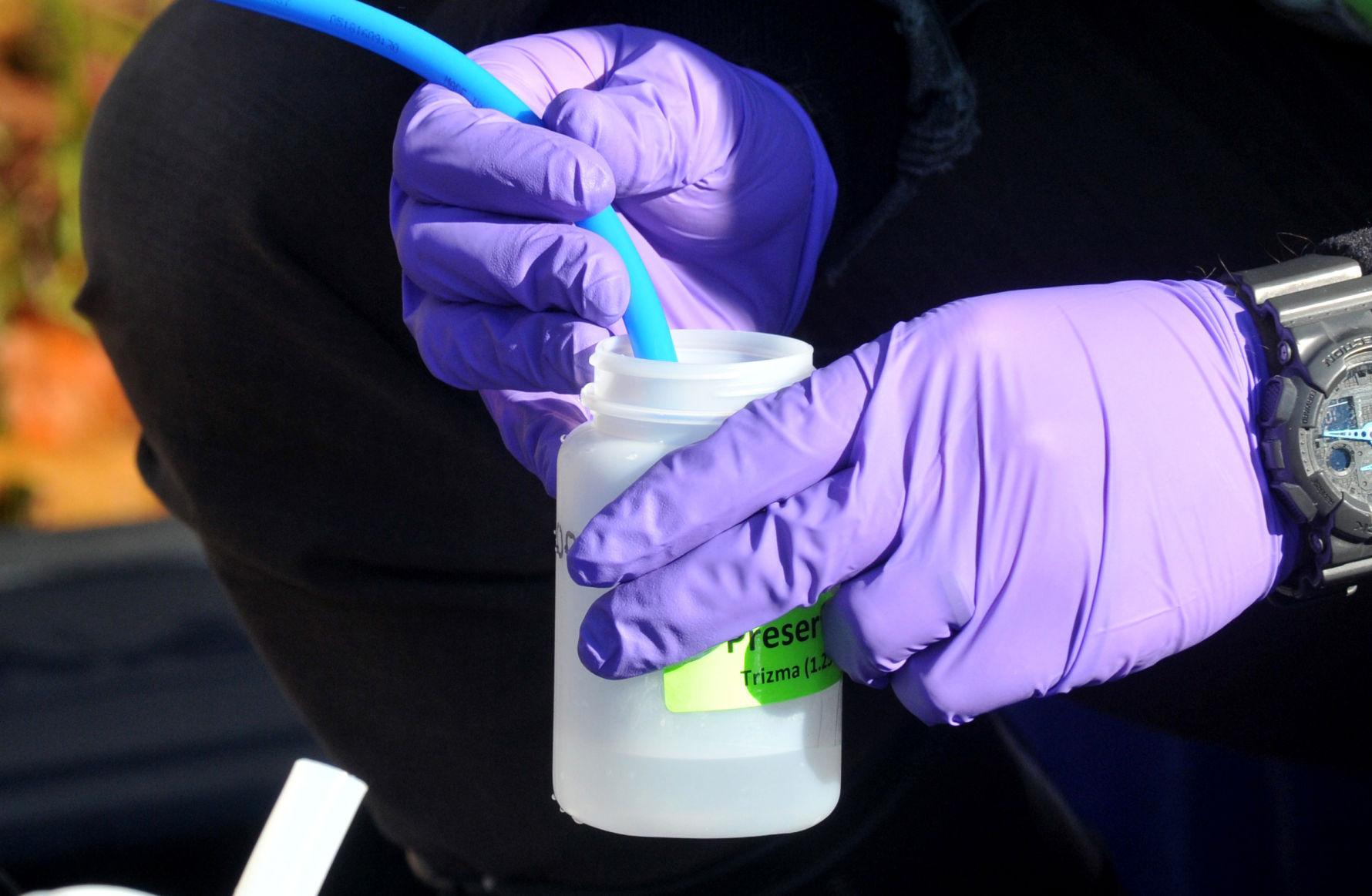
Records: Military knew of foam dangers in 2001
This story was first published on July 16, 2017.
By 2001, the U.S. military knew firefighting foams used at bases across the country could break down into toxic chemicals, that the chemicals had entered streams and groundwater at several military bases, and that they could potentially be polluting drinking water wells.
But despite one Department of Defense employee’s prediction that phasing out the foams could be an environmental task rivaling the magnitude of asbestos removal, the military continued to use the foams — without investigating whether anyone on or off the bases had been sickened, according to military records and emails.
The records were obtained by Philadelphia law firm Williams Cuker Berezofsky, which is suing the federal government over groundwater contamination near a trio of former and current military bases in Bucks and Montgomery counties.
Over the past several years, more than 16 public and 200 private wells, currently serving an estimated 70,000 people along the counties’ shared border, were found to be contaminated with high levels of PFOS and PFOA, which came from the firefighting foams. The problem is national in scope: the military is investigating 400 sites for water contamination, finding it at more than two dozen bases so far. The contamination has reached drinking water supplies in states as diverse as New Jersey, New Hampshire, Colorado and Washington.
Mark Cuker, the firm’s lead attorney on the case, provided this news organization with an exclusive look at the 170 documents, totaling more than 3,100 pages and spanning the 1970s to this year.
“Only recently have people learned of high levels of (foam chemicals) in their drinking water and in their blood. But the Defense Department and the foam manufacturers have known for over 30 years that these products endanger both human health and the environment,” Cuker said of his reaction to the documents. “Yet, they quietly continued to make and use these deadly products. They need to take responsibility for what they have done.”
This news organization reached out to the Department of Defense for comment on this story. Due to litigation, the request was forwarded to the Department of Justice.
“The Government declines to comment,” wrote Mark Abueg, public affairs specialist with the Justice Department.

3M: Halting foam making
Of particular interest are actions the military took in the year following a 2000 announcement by chemical company 3M that it would stop producing firefighting foams because of concerns about an ingredient, PFOS. In the years before, 3M found PFOS in the blood of everyday Americans and worried the chemical was toxic, persistent and accumulating in the bodies of animals — a trifecta that draws harsh scrutiny from government regulators.
3M was the military’s primary provider of “aqueous film-forming foam,” which was used ubiquitously across all military branches. Modified versions of the foams are still considered an essential safety tool for the military because of the foam’s superior firefighting performance.
Other foam suppliers used a different process than 3M, called telomerization: Their foams didn’t contain PFOS but eventually were found to break down into PFOA, a similarly concerning chemical. Both PFOS and PFOA have been linked by some studies to a range of illnesses, including reproductive and developmental issues, gastrointestinal diseases, and some cancers.
Records show Curtis Bowling, then-assistant deputy undersecretary of defense for force protection, led the DOD’s reaction to 3M’s announcement.
In early 2001, he wrote a memo to environmental and safety officials with the Army, Air Force and Navy, as well as personnel with the DOD, Environmental Protection Agency, Federal Aviation Administration and National Fire Protection Association, inviting them to a March 16, 2001 meeting at the Pentagon to discuss the issue. The memo said EPA data indicated “PFOS chemicals are persistent, bioaccumulating, and toxic.” It added that “PFOA and telomer are also persistence (sic) in the environment and more toxic than PFOS.”
In addition to planning for a potential foam ban, the meeting would also be used to “discuss ‘high-risk’ uses of PFOS and what should be done to reduce or eliminate environmental releases of the chemical. We will also determine if DOD should switched (sic) to PFOA or telomer instead of PFOS.”
Meeting minutes from that March 2001 workshop weren’t included in materials turned over by the military, but military records turned over to the law firm do contain memos sent before and after the March 16 workshop. One email chain, circulated around the Navy’s aircraft carrier program, had personnel discussing potential impacts to outfitting ships like the USS Carl Vinson and USS Ronald Reagan.
Jeff Fink, a deputy systems engineering manager with the program, wrote there was a “question” about whether the telomer foam companies “will stay in the market knowing that 3M got out and why they got out.” He mentioned the March 16 meeting and noted, “If production of (foams) is discontinued there will certainly be a major impact to Carriers as well as the rest of the Navy.”
“The effort could be on the magnitude of asbestos elimination,” he wrote. “However it is to (sic) early to panic and discuss corrective action. We need to let the tech community and industry experts have a chance to assess the total picture and develop a (plan of action).”
A number of other emails chains looped in occupational and environmental health personnel. In an email to Isaac Atkins, director of occupational health policy with the Office of the Deputy Undersecretary of Defense for Environmental Security, Bowling said: “We need to talk about the occupational exposure of telomers.” The documents show no further follow-up.
KK Phull, with the Office of the Deputy Assistant Secretary of the Army for Environment, Safety, and Occupational Health, wrote an email to Bowling responding to a request from the March 16 meeting to create a series of questions to help “minimize the impact of a future (foam) ban by EPA.”
In addition to logistical concerns about foams, Phull questioned the potential “need for occupational assessments and medical monitoring based on the review of available data: exposure monitoring, medical monitoring, population to be monitored, cost.” He also recommended the surgeon general’s office be included in a DOD “steering group” on the foams.
Those health recommendations didn’t appear to make the final cut for action. In an April 2001 memo, Bowling asked each military branch to assess its stock of foam, what uses were “mission critical,” and other logistical details. The memo didn’t mention any occupational or health programs but requested the military services “identify any operations that release PFOS-containing materials to the environment and take appropriate steps to prevent or stop these releases.”
The surgeon general’s office wasn’t included on the memo’s distribution list.
DuPont gets involved
The military communications got the attention of Stephen Korzeniowski, then a business manager for chemical company DuPont’s fluorosurfactants unit. Those chemicals were used to make firefighting foam and a variety of consumer products.
In late March 2001, Korzeniowski emailed Air Force contractor and senior foam researcher Douglas Dierdorf to question him about why Bowling called PFOA “more toxic” than PFOS in his memo to military personnel earlier that year. Korzeniowski sought the data behind that assertion, saying DuPont would share its data and the results of “several meetings we had with the US EPA over the past year.”
Records from the military show Dierdorf forwarded Korzeniowski’s email to Bowling, then drafted a letter for Bowling to sign and send to DuPont. The resulting letter from Bowling to Korzeniowski said the military knew the foam’s use “results in the distribution of chemical components in the surface and in the groundwater.”
“Concern about this distribution prompted Military Service Departments to investigate the biodegradation, possible remediation, toxicity, fate and transport of many of (foam’s) components. These studies date to 1983 or earlier and are ongoing,” the letter stated.
Bowling’s letter also said that, in 1998, several weeks after “allegations” that large-scale foam use led to a bird-kill in Jacksonville Bay, Florida, the Air Force Research Laboratory there screened nearby water bodies. The screening suggested a DuPont telomer foam had degraded into a chemical family that included PFOA. Bowling said studies such as that one were “unpublished” and “experimental,” but offered to send DuPont copies.
Based on reviews of studies on potential health effects, Bowling also wrote that his office believed chemicals resulting from telomer-based foams could cause health effects at lower exposure levels than PFOS foams.
Reached for an interview, Korzeniowski, now a private consultant, said he didn’t recall if DuPont responded to Bowling’s letter and another employee would have been asked to respond because of the technical data.
“I don’t think I had a response,” Korzeniowski said. “I’m not a toxicologist.”
Prior warnings
Although not mentioned by Bowling, the military was privy to other prior warnings on firefighting foams.
In 1999, Oregon State University researchers published a study disclosing, for the first time, that perfluorinated compounds such as PFOS and PFOA existed in groundwater below three military bases they examined: the Naval Air Station Fallon in Nevada; Tyndall Air Force Base in Florida; and Wurtsmith Air Force Base in Michigan.
Former researcher Dierdorf said the 1999 study, conducted by doctoral candidate Cheryl Moody and adviser Jennifer Field, was a breakthrough in identifying the chemicals.
“That was part of what really kicked off the whole thing ... (the) discovery that it was pervasive in the water at the bases,” Dierdorf said.
A photocopy of the study was in the records the military provided to Cuker’s law firm. On the study’s cover, someone had scribbled, “What is significance of findings?” A second, handwritten note answered: “Significance is it was funded by EPA. Indicates their (sic) getting interested in AFFF.”
In August 2000, the Navy Technology Center for Safety and Survivability hosted a “DOD AFFF Environmental Meeting” in Washington, D.C. Several presentations were delivered by Baltimore-based environmental engineering firm Hughes Associates, now doing business as Jensen Hughes. Various military records indicate the company was a consultant to the DOD on firefighting foam and other fire protection issues.
William Ruppert, with Hughes Associates, delivered a presentation that said foam byproducts could be entering bodies of water and potentially reaching drinking water sources. Despite the numerous signs that the chemicals were reaching groundwater, the military didn’t begin testing water supplies, including in Bucks and Montgomery counties, until 2014.